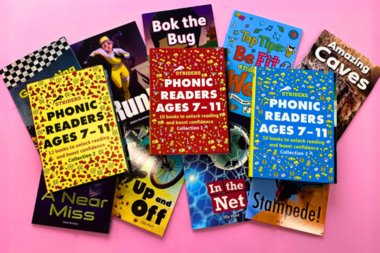Reading fluency: science and art to help students blossom
By Professor Timothy Rasinski, from the Reading and Writing Center at Kent State University, Ohio.
Years ago, as an elementary (ages 6-12) reading intervention teacher, I found there were a number of students who did not respond well to my instruction. These students could decode words in texts with some degree of proficiency, but they seemed to exhaust themselves in decoding many of the words they encountered.
Indeed, by the time they would finish reading even a short passage they were so fatigued and drained that their comprehension of what they had read was minimal at best. My instruction tended to focus on what I had learned in my undergraduate and graduate coursework at the time: phonics and comprehension. Neither seemed to work well. Something else was needed.
That something else was reading fluency instruction. Once I turned my instructional attention to fluency these students began to blossom – and in some cases the progress they made was breathtaking. But what is reading fluency?
Reading automatically and with expression
My introduction to fluency began over four decades ago – and even though fluency has been identified by research as critical to success in reading, it is still neglected and misunderstood by many well-meaning reading educators.
One of the challenges with fluency is that it is made up of two subcompetencies – the ability to read words in text automatically and effortlessly, and the ability to read orally with appropriate phrasing and expression (prosody) that reflects the meaning of the text.
Research has shown that students who read words automatically and with good oral expression read silently with good comprehension. Fluency must therefore be viewed from both of these lenses – automaticity and expression. Teaching one but not the other will not get students to where they need to be in terms of comprehension. Yet, in many classrooms one aspect of fluency is given priority over the other.

The science of teaching reading fluency
Fortunately, research and scholarly inquiry over the past several decades has shown us productive ways to teach fluency.
First, we teach fluency by demonstrating it to students; and we do this by reading to students regularly and pointing out aspects of fluency in our own oral reading to them. When reading to students I will often draw their attention after my reading to how I read with relative ease and effortlessness, how I changed my voice when I changed characters, how I altered my speed – going fast in some parts and slow in others, how I phrased text into meaningful units, how I inserted dramatic pauses, etc. And of course, my message to students is that they need to work towards reading this way as well.
Audio-assisted reading is another approach for building fluency in students. If students have difficulty reading a text on their own, they will benefit by reading the text with someone who is a more fluent reader. In doing so the student gains from hearing an effortless and expressive rendering of a text while simultaneously reading it on her or his own. Assisted reading can take the form of choral reading with a group, reading with a single partner such as an older classmate or an adult, or reading while listening to a fluent reading of the text and listening to a fluent reading of the same text that has been previously recorded using technology.
Repeated reading is a third approach to building fluency in students. In this scenario, students read a text several times until they are able to read it on their own independently and with good fluency. Scientific research has shown that students who engage in repeated reading not only improve on the text they practice, but there is also generalised improvement in fluency and comprehension on new passages never before read.
The science points the way to improve fluency and overall reading proficiency. The challenge is how to do the science in ways that are authentic and engaging for students. Currently, because of the emphasis on measuring fluency by reading rate, much of the scientific fluency instruction is aimed at getting students to read ever faster. I do not find such an approach authentic, or for that matter truly effective in improving reading outcomes. What is needed is an artful approach to scientific fluency instruction.
Artful instruction: authentic, creative and aesthetic
Artful instruction can be characterised as authentic – reflects what happens in the real world; creative – allows teachers and students to explore new worlds and ways of expressing themselves; and aesthetic – is aimed at touching the heart as well as educating the head.
So, the artful question for fluency is this: what would motivate someone to read and listen to a text multiple times with an aim of improving effortlessness in the reading as well as expression? The artful answer to that question is performance. If a reader knows that s/he will be performing a text for an audience, they have an authentic and purposeful reason for working on fluency.
Of course, the next question is: what kinds of texts are meant to be performed for an audience? The answer includes a variety of text types such as narratives and stories, but also other artful texts such as poetry, songs and scripts. When students practice (rehearse) such texts their aim is not on reading such texts quickly but reading with appropriate expression that will convey meaning and aesthetic satisfaction to an audience.
A growing body of scientific research is demonstrating that students who engage in this artful and scientific approach to fluency instruction not only improve their reading word accuracy, automaticity and prosody, but also their reading comprehension. Moreover, students find great motivation and satisfaction in such approaches to fluency. Later, as students become more familiar with these types of texts, they can exercise their creative muscles in writing and performing their own poetry, songs and scripts.
Teaching reading is a science, no doubt. However, the best teaching of reading is not only science, it is also an art. This is the challenge that I make to all teachers of reading – follow the science in what matters when it comes to teaching reading; and also become that artist who finds authentic, creative and aesthetic ways to deliver that scientific instruction to students so that they themselves become not only proficient, but also ultimately lifelong readers.

Timothy Rasinski is Professor of Education in the Reading and Writing Center at Kent State University in Ohio where he also holds the Rebecca Tolle and Burton W. Gorman Chair in Educational Leadership. In a recent study by Stanford University, Dr Rasinski was named in the top 2% scientists in the world. He is author of The Megabook of Fluency, published by Scholastic.
Scholastic Reading CPD
You can now watch Professor Tim Rasinki’s virtual CPD session on how to incorporate fluency into your lessons and improve your pupils’ word recognition, reading expression, comprehension and reading proficiency. Originally broadcast on 20th October 2021, the video is available to view on the Scholastic Resource Bank CPD Video Library "here.":https://resource-bank.scholastic.co.uk/content/42944
Similar Posts
-

Guided reading: What’s in a name?
Advice for teachers on the practice of guided reading, by Sue Bodman and Glen Franklin from the UCL Institute of Education.
-

Building Confidence at Home with 11+ Practice Books: A Parent’s Guide
Hear from Alima Rahman, a full-time 11+ English tutor and founder of Bright Minds Club – 11+ Tuition, as she talks about how parents can help build confidence in their child at home with the Scholastic Pass Your 11+ range.
-

The Challenges of Teaching Phonics Beyond KS1
Hear from Mr Levick, a phonics specialist in secondary school and former primary English subject lead, about the challenges of teaching phonics beyond KS1 and how Striders phonics readers can help.
